First Person Singular
Think of these as mostly Krishna telling about himself. For instance icchāmi — I wish
Data Science with Bhagawat Gita: For Building Intuition in Understanding

A peek into Visualizations, High frequency words, Alphabet Dictionary & Linguistic cues in the Divine Song!
A friend once said, “Reading the Gita had downloaded enormous serenity in me. No matter what happens outside, it is still from inside”.
It takes a lot of courage and serendipity to read the Gita. I had been procrastinating it long for the fear of vocabulary and clouding of attention. Every word has to be experienced in this song and translations perhaps aiding just like Google Maps. Arjuna was blessed with a vision to behold the divine cosmic form. At a very gross level, can we behold the words that weave this Song? For those who are familiar with the verses and the meanings, I feel the patterns will help in building intuition in understanding.
Recently I was reading about Twitter Analysis with Data Science and it stuck to me, “Why not try with Gita?”
What are the number of words? What was the conversation style? Were there any grammar patterns to learn? How did the Alphabet wise Dictionary look?
Let us begin with the number of chapters and verses in each.
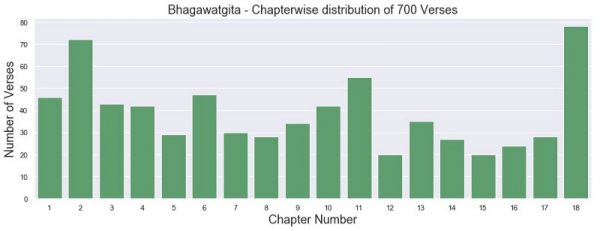
Now let us look into the number of words in each Chapter. About 10K words make up these 700 verses. Seems like a big number to digest… Like a Data Scientist, let us work in the Frequency Domain. Not all the 10K words are unique.Let us make a table of words and their frequency.
Constructs of the Gita language
For simplicity, let us bucket the entire 10K words into Connectors, Pronouns, Verbs and Nouns.
CONNECTOR WORDS
Just like in English, the connector words seem to top the list. Usually they are discarded in Data Science Sentiment Analysis as they are filler words and ambush the main message. However let us use them to get some cues on the mood and the conversation style.
Was it one sided preaching? Where there any questions? Any negations? Were the sentences complex? Where there examples and illustrations?
I am sure you will make a guess looking by skimming through the below diction and its frequency.
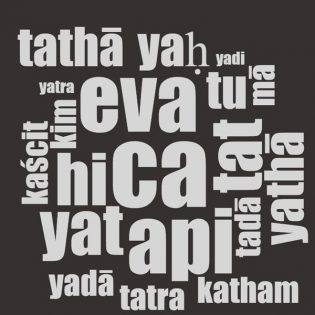
High Frequency Connector Words in Bhagawat Gita
Complex sentence connections?
and-certainly-therefore
ca (and) 392 evam (thus) 30
eva (only/indeed) 173 hi (certainly) 67 tu (indeed) 66
iti (like this)65 tasmāt (therefore) 25
[~850 occurrences]
abhyāsena tu kaunteya vairāgyeṇa cha … [Certainly with practise and with detachment]
evam ukto hṛiṣhīkeśho [and thus addressing] [1.24]
karmaṇi eva adhikāras te [Only you have right over …]
iti ahaṁ vāsudevasya [Like this I have heard] [18.74]
Cause Effect & Illustrations
when-then, where-there, as-so
yadā tadā (when then) 24
yatra tatra atra kutra(where-there) 20
yathā tataḥ (like similarly)-70
[115]
yadā yadā hi dharmasya … tadā ātmānaṁ [When ever there is .. at that time][4.7]
yatra yogeśhvaraḥ kṛiṣhṇo yatra pārtho … tatra śhrīr …[Where there is krishna & Arjuna, There is wealth …] [18.78]
yathā ākāśha-sthito nityaṁ… tathā sarvāṇi bhūtāni … [Just Like how the Sky is stationary… Like that All beings] [9.6].
Lot of Q&A
Negations & Questions : no, do not, how, why
na (no)256 mā (do not) 9 katham (how)9 kim (why)21 [305]
mā phaleṣhu kadāchana [not entitled to the fruits][2.47]
na inaṁ chhindanti śhastrāṇi [not can the weapons tear][2.23]
Miscellaneous
mahā 43 sarva 67 param 36 śrī 29 punaḥ 21 [196]
The frequent connectors listed above add up to a 1500 words of the 10K list!!
PRONOUNS
Was it predominantly conversation between 2 friends (First Second person)? Did it have references to Others? (Normal people, Exemplary People, Objects?) (Third Person).
First Person: aham (I)103 mām (me) 84 me 61 mama (my)24 mayā (by me) 22 mayi (in me)20
Second Person: tvam (you) 31 tvām (to you) 20
Third Person: ye te (those who -they) 95 yaḥ saḥ (he who…he) 140 tasya (their)21
yat -tat (that which-that) 170 idam (this) 39 etat (these) 25 ayam (this) 24 iha (in this)21
900
mayi āveśhya mano ye māṁ nitya-yuktā upāsate
śhraddhayā parayopetās te me yuktatamā matāḥ [12.2] [ye-te-me] [mayi māṁ]
Those (ye) who fix their mind on me(mayi) and always engage devotion to me(māṁ) , they (te) are considered by me (me)to be the best yogis.
ahaṁ vaiśhvānaro bhūtvā …[15.14] I am the digestive fire…
iti te jñānam ākhyātaṁ guhyād guhyataraṁ mayā … [18.63] In this manner the knowledge which is utmost secretive has been revealed to you by me …
The small list of the above pronouns revolving around ‘me’, ‘you’, ‘they’ and ‘it’ sum up to about 900 words.
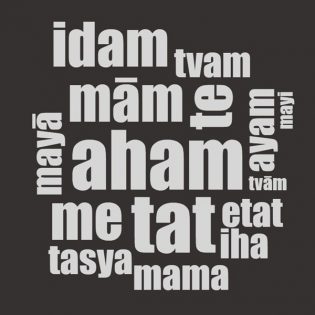
Common Pronouns in Bhagawat Gita
NOUNS
Let us look into what the Nouns speak as they contain the main message. I have clustered them under themes for easy classification purpose.
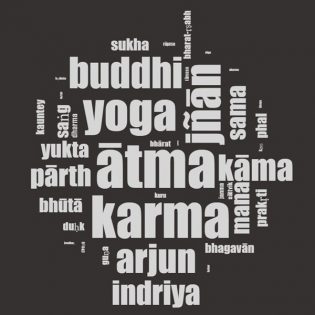
Names of Arjuna & Krishna
arjun 48 pārth 42 kauntey 25 bhārat 22 kṛṣṇ 14 bharat ṛṣabh 8 guḍākeś 4
bhagavān 28 keśav 7 hṛṣīkeśa 5 govinda 2
205
Related to Moderation
yoga 105 jñān 91 yukta (moderation) 38 sama (equananimity) 41
275
Related to Karma (Action)
karma 119 kuru (do)18 phal(fruit) 32 saṅg(attachment) 34 akarma 8 dharma 20
247
Related to Bhakthi (Devotion)
brahma (creator) 42 bhava (emotion) 10 bhakt (devout) 25 deva (demi gods)35 yagna (sacrifice) 12 bhog (enjoy)15 priya (dear)21 upāsana (worship)6
154
Ascent through Sense Organs, Mind, Intellect & Soul
indriya (sense organs)43 mana (mind) 39 buddhi (intellect)55 ātma (soul)136
273
Various Emotions
kāma(lust) 44 duḥk(sad) 28 sukha(happy) 32 rāga(love) 10 dveṣa(hate) 13 bhaya(fear) 8 krodhaḥ(anger) 6
135
Physical Elements & Traits
bhūtā (elements) 72prakṛti(physical nature) 29 guṇa (attributes) 23 janma(birth) 17 mṛtyu(death) 10 tāmasa(inert) 15 rājasa(passionate) 14 sāttvik(good) 15
200
The above Noun list comprises around 1153/10K words in the Gita.
VERBS
Let us look into the action words and get a sense of Verb usage in the Gita.
uvāca (narrated) 64 śṛṇu (hear) 13
The different forms of the word ‘am’
asmi 39 (am) asti (is)18 asi (you are) 17
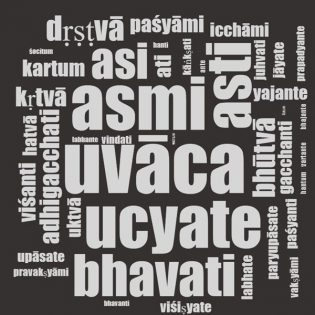
First Person Singular
Think of these as mostly Krishna telling about himself. For instance icchāmi — I wish
Present
paśyāmi (I see) 7
icchāmi (I wish) 6
visṛjāmi (I create) 2
hṛṣyāmi (I take pleasure) 2
dadāmi (I give) 2
sambhavāmi (I appear) 2 śaknomi (I am able) 1
Future
pravakṣyāmi (I shall explain) 4
vakṣyāmi (I shall explain) 4
Total 34
Second Person — Should be mostly Krishna addressing his friend Arjuna.
asi (you are)17
arhasi (befitting you)10
avāpsyasi (you will attain) 4 prāpsyasi 2 (you will attain)
icchasi (you desire)3
36
Third person verbs would be interesting. Actions pertaining to different kinds of people (the exemplary and not so exemplary), actions pertaining to objects. It is interesting to note that singular usage seems more prevalent than plural usage.
Interestingly in Sanskrit there are 2 kinds of verbs. Crudely a) the sophisticated higher order verbs like arise-born-bloom-gain and b)day to day action verbs which are associated with nouns like sit-eat-give-go. Based on the suffix patterns one can differentiate both of them.
Third Person Singular
For instance – saḥ ucyate — he calls
ucyate (calls) 28
Sophisticated: vidyate (is there) 9 upāsate (worships) 5 paryupāsate(worships) 5 labhate (gains)5 jāyate (takes birth )5 viśiṣyate (becomes special) 5
Regular: bhavati (happens)17 paśyati (sees)12 adhigacchati (attains) 8 juhvati (offers) 5 kāṅkṣati (desires) 4 vindati (enjoys) 4 praṇaśyati (is lost) 3 tiṣṭhati (stands) 3 prakāśayati (illuminates) 3
tyajet (should sacrifice) 3 bhavet (would be) 2 āgacchet (should come)1
Total 150
Third Person Plural
viśanti (falling down)7 gacchanti (go) 6 paśyanti (see) 5 bhavanti (are) 3 nibadhnanti (bind) 3 bhajanti (pray)2
Total 26
Past Tense Singular
dṛṣṭavān (saw) 2 proktavān 2 (told) abravīt (spoke) 3
“Having” verbs.. After having done XXX did yyy
dṛṣṭvā tu pāṇḍavānīkaḿ…. rājā vacanam abravīt [BG 1.2][Having seenPandavas…he spoke]
dṛṣṭvā(having seen)11 tyaktvā(having relinquished)13 jñātvā(having known)12 bhūtvā (having become)9 kṛtvā (having done)8 uktvā(having said) 6 hatvā (having killed) 6 śrutvā (after hearing)3
āśritya (having resided) 3 labdhvā (having obtained) 2
Total 70
“To XXX”
… na kaśhchit kartum arhati [no one able to cause ] [BG 2.17]
na tvaḿ śocitum arhasi [you do not deserve to lament] [BG 2.27]
kartum(to do)7 śocitum(to lament)3 hantum(to kill)3 veditum(to know)2 āptum (to attain)2
Total 17
Doing XXX , I am doing yyy (Sense of accompanying verb XXX done in parallel with yyy)
paśyañ śṛṇvan spṛśañ jighran
aśnan gacchan svapañ śvasan …. vartante iti dhārayan [BG 5.8]
seeing, hearing, touching, smelling (accompanying verbs)…
kurvan (doing) 5 paśyan (seeing)3 smaran (remembering)3 yuñjan (uniting)3
Total 17
That was a total of 446 Verbs out of the 10K Words!!
In this manner of skimming through high frequency words, we have covered about 1600 Connectors, 900 Pronouns, 450 Verbs and 1200 Nouns. That makes it around 4K out of the 10K words in the dictionary.
And we did get a feeling of the language and the conversation style. This is absolutely IMPRESSIVE..
Noun Context Patterns
A peek into few popular noun patterns for different contexts. In Sanskrit, the context is embedded in the form of suffix. This is the wonder in Sanskrit which gives it the unique property of making the sentence valid no matter how the words are shuffled.
For beginners, I like this approach as it reinforces context patterns in a natural way. I have taken them from popular verses which follows a constant pattern.
Kartha, the Subject(aḥ)
saḥ (he) yaḥ (he who )
manaḥ (mind) yogaḥ puruṣaḥ(person)
arjunaḥ sañjayaḥ
Karma, the object (am)
patraṁ puṣhpaṁ phalaṁ toyaṁ [9.26] leaf, flower, fruit, water
Karana, the Instrument of Action: [With] (ena/eṇa suffix)
abhyāsena tu kaunteya vairāgyeṇa cha gṛihyate [6.35] With Practise, With Detachment
abhyāsena (with practise)
vairāgyeṇa (with detachment)
yogena (with Yoga)
Sense or Offering: (aya)
paritranaya sadhunam vinasaya ca duskrtam … [BG 4.8]
paritrāṇāya (to protect)
vināśhāya (to annihilate)
sansthāpana-arthāya (to establish)
Sense of Position: At Kurukshetra, At the War ..
dharma-kṣhetre kuru-kṣhetre … [BG1.1]
dharmakshetre (at the place of dharma), kurukshetre (at kurukshetra), madhye (in between)
Cause & Effect Scenarios: From X arise Y.. From Y arises Z.. Or Compared to X, Y is … Compared to Y, z is… In Sanskrit, the common noun suffix for Cause is ‘at’, ad’
krodhād bhavati sammohaḥ … [BG 2.63]
annād bhavanti bhūtāni … [BG 3.14]
śhreyo hi jñānam abhyāsāj jñānād dhyānaṁ viśhiṣhyate
krodhāt (from anger) sammohāt (from confusion) smṛiti-bhranśhāt (from clouding of memory) buddhi-nāśhāt (from clouding of judgement)
annād (from rice) parjanyād (from rain) yajñād (from sacrifice)
Relational Words: Arjuna’s Bow, Arjuna’s Sorrow.. The common noun suffix for Relation is ‘sya’
tasya (his) dharmasya (dharma’s)
Plurality in Nouns. Let us see a few examples of different noun contexts in plural forms.
Object: indriyāṇi (sense organs) śastrāṇi (shastras) bhūtāni (elements)
Sense of Relativeness: This pattern is found consistently in verses 10.21 to 10.31 of Vibhuthi Yoga. In the description of plurality and opulances, Krishna describes “among A I am B, among C, I am D, among E I am F…”
vedānāṁ sāma-vedo ’smi devānām asmi vāsavaḥ
indriyāṇāṁ manaśh chāsmi bhūtānām asmi chetanā [10.22]
I am the Sāma Veda among the Vedas, and Indra among the celestial gods. Among the senses I am the mind; Among the living beings I am consciousness.
Sense of Location: When I first heard, I was intrigued by this chapter ending line…What did these suffixes mean? They have such a rhythmic effect.
Shrimad-Bhagavad-Gitasu Upanishadsu Brahmavidyayam Yogashastre Shri Krishna-Arjuna-samvade
In the Gitas, In the Upanishads, In the Brahma Vidhya & Yoga Shastras, In the conversation between Krishna & Arjuna
Other descriptors used for indicating infinity, unperishable, fore ever and plurality sense are akshaya, avyaya, anantha, sanathana, nana, bahu, aneka. These are naturally to be found in the Vibhuthi Yoga Chapter.
Gita Dictionary analysis
We are done with the frequency analysis. Let’s change gears and inspect How many words begin with Each letter.
Any guesses on the popular Alphabets? I have represented characters as per Sanskrit Alphabet matrix (swara & vyanjana) and for simplicity, clustered the consonant pairs.
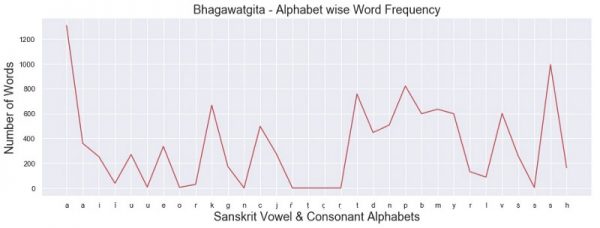
Looks like words starting with ‘a’, ‘s’, ‘m’ are very popular.. Interesting that there were no words from the retro series ‘ṭ’, ‘ḍ’, ‘ṇ’.
If we were to list the top word in each alphabet. Here is the list.
aham 103 ātmā 37 iti 65 īśvaraḥ 8 uvāca 64 ūrdhvam 3 eva 173 aiśvaram 4 oṁ 4 auṣadhīḥ 1 ṛṣabha 8
karma 84 khe 1 guṇa 16
ca 392 chinna 3 jñānam 31 jhaṣāṇām 1
tat 93 deva 16 dhanam 12 na 256
pārtha 38 phalam 16 brahma 42 bhagavān 28 mām 84
yat 79 rūpam 16 loke 12 vā 25
śrī 29 ṣaṭ 2 saḥ 74 hi 67
Making of Complex Words
It seems overwhelming by the sheer number of the sophisticated words. A simple trick is to take cues from prefixes suffixes and see affinity with the underlying word. The prefixes add a sense of direction and authority to the words thereby highlighting, elevating, reciprocating or bringing a sense of Reinforcement.
Together (with): sandṛśyante (seen together) samudbhavam sammohaḥ
samupasthitam
Reinforces (forward): pravakṣyāmi (shall reveal) pravṛttim (acting properly) pratiṣṭhitā (firmly established; tishta is to stand) praṇaśyati (perishes; from ṇaś perish)
Reciprocating (backward) : pratiyotsyāmi (fight back; yuddh meaning fight)
Elevate (beyond): ativartate ( transcends; vartate is dwelling) atitaranti (cross overs; taranti is swim)
Follow (behind): anuvartante (follow) anupaśyati (see; pasyati is to see) anusmara (remember) anudarśanam (observing; darshan is to see)
Towards : abhijānāti (get to know; jānāti is know)
abhijāyate (take birth; ja is birth) abhirakṣitam (well protected)
Descend (down): avagaccha (understand; gaccha is go)
avajānanti (disregard) avajñātam (with contempt)
Forks in Proximity : upajāyate (gives rise to) upalipyate (mixes)
upajuhvati (worship; juhvati is offer) upasaṅgamya (approached; sangam is union) upadraṣṭā(witness)
METHODOLOGY
My knowledge of Gita meanings and recital are from the handpicked verses from my Yoga Course at SVYASA university few years back. Composed in the Anustup meter poetic style, there was a poise and resonance in its rendering. Based on what seemed like repeating patterns to my ear, I conducted this experiment on the Gita text obtained from Kaggle website and deployed Python and Data Science modules for text parsing, iterating and book keeping of the patterns. As the English character set is lossy and cannot represent all the Indian Alphabets accurately, an extended version with diacritics (IAST) that is used internationally in Sanskrit transliteration has been used for the analysis.
The techniques described are still rudimentary as it involved multi stage parsing. In the first pass, the words were listed based on descending frequency. The connector set was extracted manually from this set. The nouns owing to their different suffixes for different contexts need to be normalized which further increases the frequency. This was done in iteration 2 for the high frequency nouns. In addition, it was grouped with relevant words to make the word list more relevant. Verb list was obtained by extracting words with popular suffix endings. An automatic tagging of all words into these 3 types would aid in the accuracy of classification.
APPLICATIONS
A head start and feel for the seekers of Gita.
It could be used in the field of NLP and Education in Schools and Universities. For instance Visualizations and grammar weaved around a topic makes the subject easier to study. Top 20 words from each alphabet, top 20 verbs, top 20 nouns gives a theme around learning.
The tools used could be extended to Visualise messages in other texts like Ramayana, Patanjali Sutras, Lalitha Sahasranama etc, Works of Shankaracharya and visualise the message and conversation style.
There are subtler aspects like highlighting Acoustic Patterns in words, Anustap and other meter visualisations in sub verses, Chapter wise sentiments, Verse wise sentiment, Speciality about first-last word of a Verse, Classifications etc. This would need some more thinking and coding. May be I will work on this in my next break.
HELPFUL REFERENCES
GITA VERSES
Bhagawat Gita as it is by Bhaktivedanta Swami Prabhupada
Translation by Swami Mukunda Nanda (Good cross References)
DICTIONARY
CHANTING REFERENCES
Chanting (along with meaning subtitling )by Swami Chinmayananda
GRAMMAR REFERENCES
This article was first published at medium.com and republished here with the author’s suggestion and permission.
Featured image courtesy: Dark Reading and Medium.